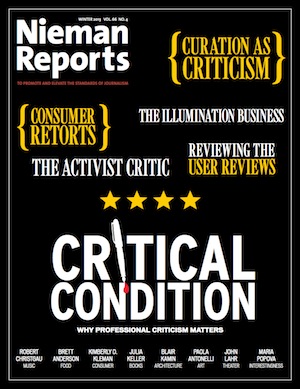Here, Kimberly D. Kleman, editor-in-chief of Consumer Reports, notes how her magazine has used the explosion of user reviews online to find ways to add value to their work.
 Greetings from 50 testing labs humming with spinning washers and dryers; illuminated with newfangled light bulbs and supersized TVs; ambrosial with the aroma of hundreds of just-baked cookies from dozens of ranges and wall ovens; chilly from the steady blast of room air conditioners; striped and splattered from assessments of paints and stains; and buzzing with trained tasters sampling chocolates or beef jerky or sparkling wine. In other words, the Yonkers, New York headquarters of Consumer Reports, which puts to the test more than 3,000 consumer products each year.
Greetings from 50 testing labs humming with spinning washers and dryers; illuminated with newfangled light bulbs and supersized TVs; ambrosial with the aroma of hundreds of just-baked cookies from dozens of ranges and wall ovens; chilly from the steady blast of room air conditioners; striped and splattered from assessments of paints and stains; and buzzing with trained tasters sampling chocolates or beef jerky or sparkling wine. In other words, the Yonkers, New York headquarters of Consumer Reports, which puts to the test more than 3,000 consumer products each year.
I know, I know. That sounds nothing like your newspaper, magazine, Web operation or the spare bedroom where you write your reviews. But an important lesson Consumer Reports has learned from user reviews — namely, how to use them to become stronger — is applicable to a range of professional reviewers, I believe.
You might think that an organization like ours would react in one of two predictable ways to the proliferation of user reviews you can now find for pretty much anything you want to buy:
Dismiss them as trivial and unscientific. After all, we’re the organization that spends more than $7 million each year buying not only products — from Audi sports sedans to ZVOX home theater systems — but also making or buying the testing equipment and sourcing ancillary supplies. The latter includes cotton swatches identically stained with chocolate ice cream, grass, sebum, and other blots to assess laundry detergents; Maine Coon cat fur to test the pet-hair pickup claims of vacuums; cherry-pie filling, eggs, and tapioca we use to create the “monster mash” we paint on the innards of ovens to rate their self-cleaning claims, and much more. Compare that level of testing rigor to Concepcionz and her five-star impressions on Amazon.com of her American Standard elongated two-piece toilet: “The product arrived as described, pretty good price and it arrived very safe….Everything is as described and I love the product.”